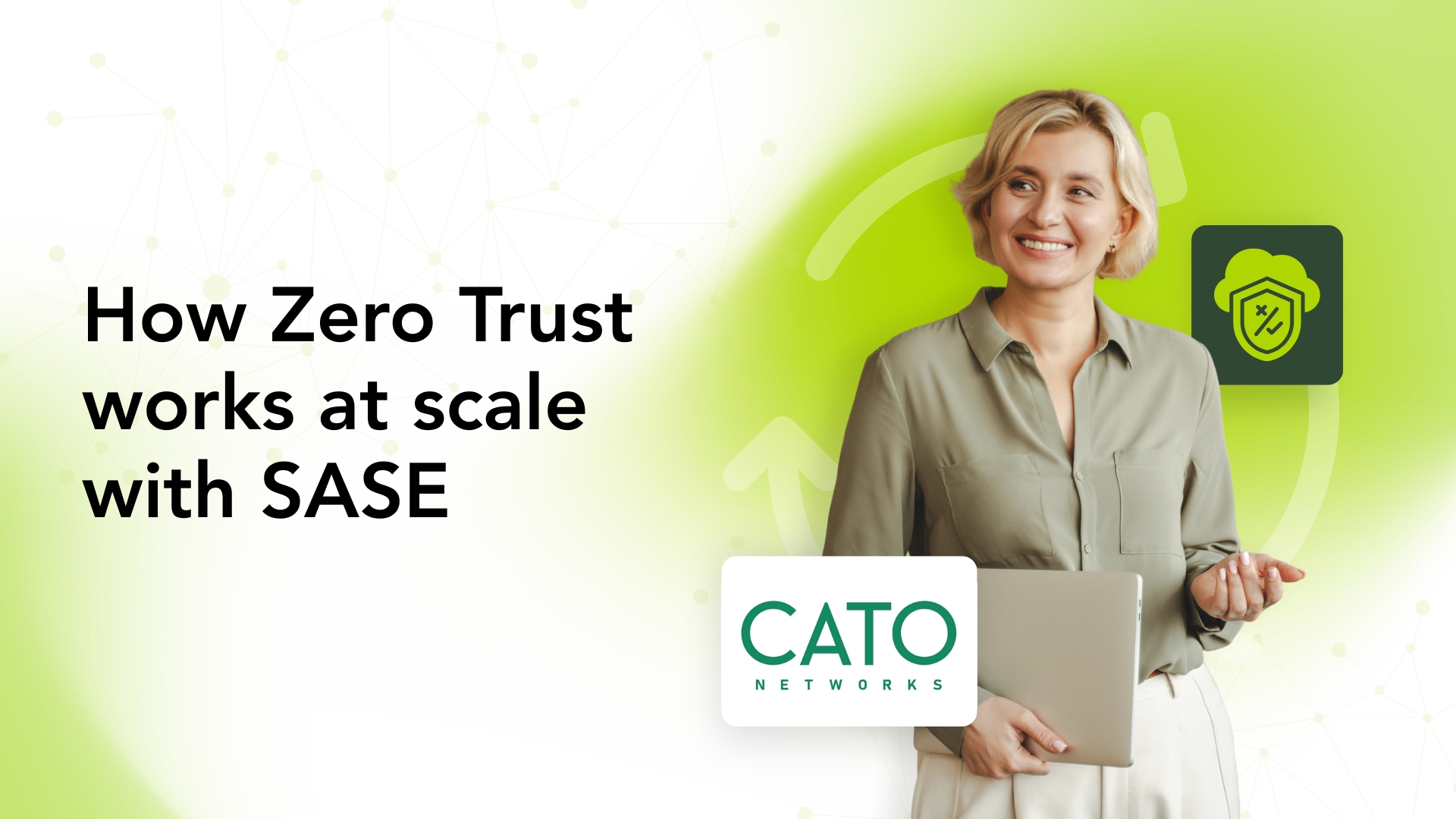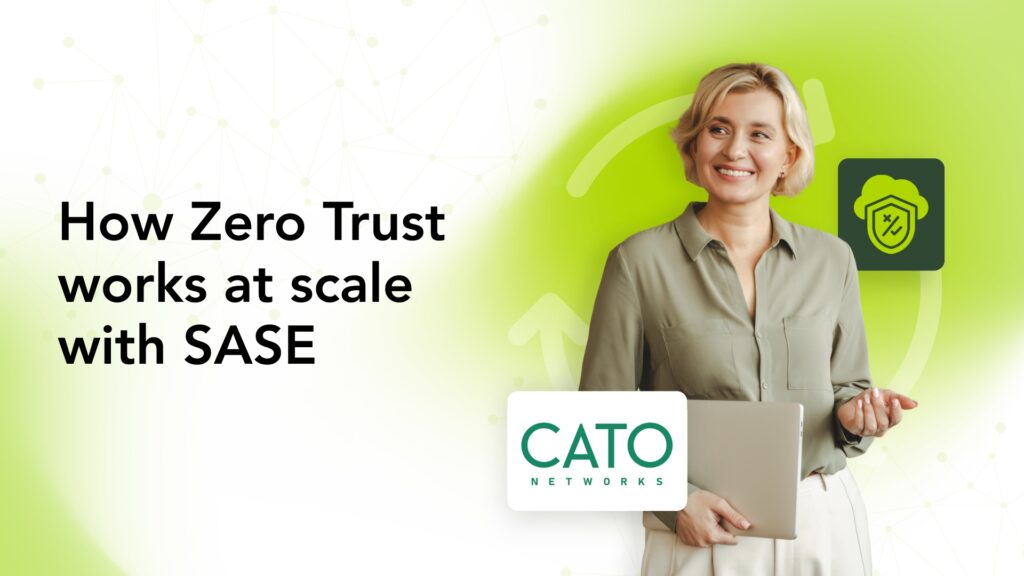Zero Trust has become one of cybersecurity’s most talked-about concepts, and one of the hardest to operationalize.
The idea is clear: never trust, always verify. But in practice, it’s often reduced to isolated tools, inconsistent policies, and good intentions that don’t quite scale.
Zero Trust works best when it’s backed by infrastructure that can support it. To apply least privilege access and continuous verification across users, devices, cloud apps, and remote locations, organizations need more than standalone tools. They need a platform designed for real-time control and consistent enforcement.
That’s where Secure Access Service Edge (SASE) starts to make a lot of sense.
SASE brings networking and security together into a single, cloud-native architecture. It gives Zero Trust the infrastructure it needs to work—consistently, globally, and without slowing users down.

When Zero Trust is delivered through SASE, identity becomes the foundation for access, policy enforcement happens at the edge, and users connect securely without relying on outdated perimeter controls. Policies follow users across locations, devices, and apps, creating a consistent experience and a stronger security posture.
What is Zero Trust Network Access (ZTNA)?
Zero Trust Network Access (ZTNA) is a modern security framework that controls access based on identity and context, not network location. Instead of trusting any device inside the perimeter, ZTNA evaluates every request before granting access to an application.
Each session is verified in real-time based on who the user is, where they’re connecting from, and whether their device is secure. If it doesn’t meet the criteria, access is denied, no matter where they are.
Key principles that define ZTNA:
- Least privilege access: Users connect only to the specific apps they’re authorized to use.
- Continuous verification: Every session is assessed in real time, not just at login.
- Microsegmentation: Application access is isolated and scoped to reduce lateral movement.
ZTNA shifts control away from static network zones and toward dynamic, identity-driven access. But on its own, it’s often difficult to scale across hybrid environments without a platform that unifies policies and enforcement.
Why Zero Trust alone falls short
Zero Trust starts strong with identity-based access and least privilege principles, but maintaining it across a growing, hybrid environment gets complicated fast.
Teams often begin with standalone tools for authentication or segmentation. Over time, those tools multiply.
Managing them means jumping between consoles, manually aligning policies, and troubleshooting inconsistent enforcement across remote users, mobile devices, and cloud apps.
The result is often:
- Policy sprawl: Multiple tools with overlapping rules lead to drift and blind spots.
- Operational drag: Manual configuration and constant oversight stretch teams thin.
- Coverage gaps: Devices and users operating outside the perimeter create risk.
Without a centralized delivery model, Zero Trust becomes fragmented—difficult to manage and even harder to scale across regions, apps, and workstyles.
How SASE makes Zero Trust actionable
The principles of Zero Trust are sound—but to enforce them at scale, you need a platform that’s built for dynamic, identity-driven access.
SASE solves this problem by converging networking and security into a single, cloud-delivered platform. It makes Zero Trust practical by embedding access controls, user verification, and security inspection directly into the network fabric, at the edge, where connections happen.
Here’s how it works:
- Built-in ZTNA enforcement: Every user session is evaluated and authorized before it reaches any app, regardless of location.
- A single policy engine: Rules are written once and enforced consistently across remote users, branch offices, and cloud environments.
- Edge-based inspection: Traffic flows through the nearest PoP, where access control, threat detection, and routing are all handled in real time.
This unified model eliminates the inconsistencies that arise when Zero Trust tools are deployed in silos, and it reduces the complexity of managing separate access, security, and networking stacks.
What’s inside a SASE platform?
A fully realized SASE model includes the following core services, often grouped under Secure Service Edge (SSE):
- Zero Trust Network Access (ZTNA): Identity-based access to apps, not networks.
- Firewall as a Service (FWaaS): Cloud-delivered traffic inspection and control.
- Cloud Access Security Broker (CASB): Visibility into SaaS app usage and compliance.
- Secure Web Gateway (SWG): Threat protection and content filtering for web traffic.
- Data Loss Prevention (DLP): Prevents sensitive data from leaving the organization.
Thinking about whether your environment is ready to make the leap? Check out 7 clear signs your business is ready for SASE adoption to see if the timing is right.
A real-world scenario: what Zero Trust and SASE look like together
Let’s say a contractor is onboarding for a short-term project. They’re working remotely, using a personal laptop, and need access to just one internal application.
Without SASE:
- You might issue VPN credentials, exposing more of your network than necessary.
- Security teams scramble to apply access controls across disparate tools.
- Monitoring and revoking access becomes a manual process and a potential risk.
With SASE:
- The contractor connects to the nearest PoP through built-in ZTNA.
- Their identity, device health, and location are verified in real time.
- Access is granted only to the one application they’re authorized to use—and nothing else.
Now multiply that by dozens of contractors, remote employees, and cloud-based tools. SASE ensures every connection is secured the same way: close to the user, governed by centralized policy, and segmented to reduce risk.
Whether users are working from a branch office, hotel Wi-Fi, or their kitchen table, access is fast, seamless, and tightly controlled.
The payoff: benefits of Zero Trust delivered through SASE
Embedding Zero Trust inside a SASE platform creates clarity and control.
Identity-based policies stay with users across locations. Traffic flows through optimized, secure paths. And IT teams gain centralized enforcement without added complexity.
What that looks like in practice:
- Stronger security posture: Every session is verified, inspected, and restricted to exactly what’s needed—reducing lateral movement and exposure.
- Simplified infrastructure: Access control, traffic inspection, and policy enforcement live in one place. Fewer vendors. Fewer consoles. Less overhead.
- Faster, smoother user experience: Users connect through the nearest PoP with policies enforced on the edge—no lag from backhauling or tool chaining.
- Audit-ready compliance: Consistent policy enforcement, centralized logging, and built-in visibility make reporting and governance more manageable.
Related: Explore how managed network services and secure networking from Momentum help support Zero Trust delivery.
Are you securing too much with too little control?
Hybrid work isn’t going away. Neither are the gaps between legacy VPNs, siloed tools, and policies that don’t follow users.
The more you scale, the harder it becomes to enforce access consistently, especially across cloud apps, mobile endpoints, and global teams.
SASE makes Zero Trust work the way it was meant to: identity-first, policy-driven, and enforced at the edge.
Momentum delivers this as a fully managed solution, powered by Cato Networks. From initial design to day-to-day operations, our team helps you transition to a converged platform that simplifies access control, strengthens your security posture, and reduces operational drag.



